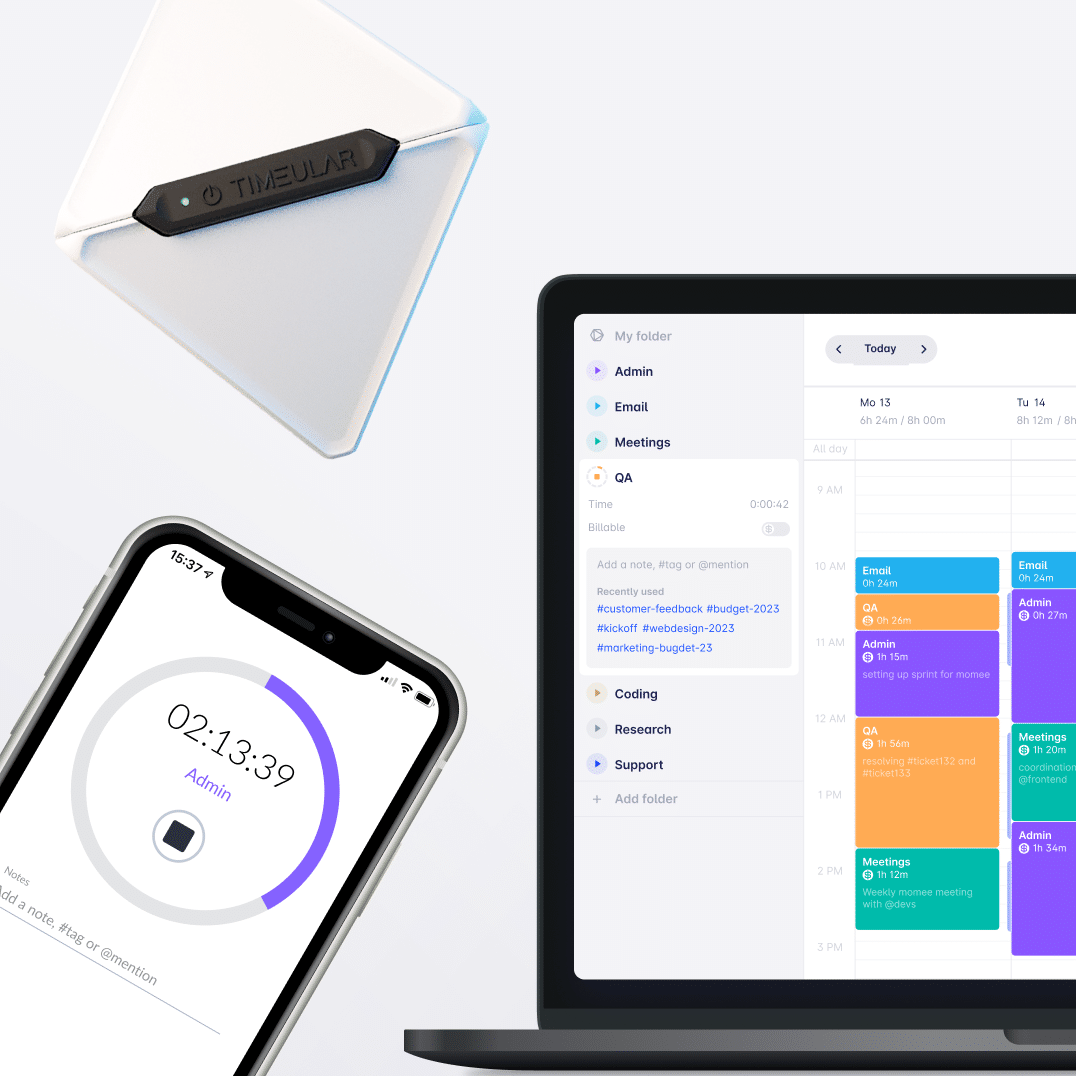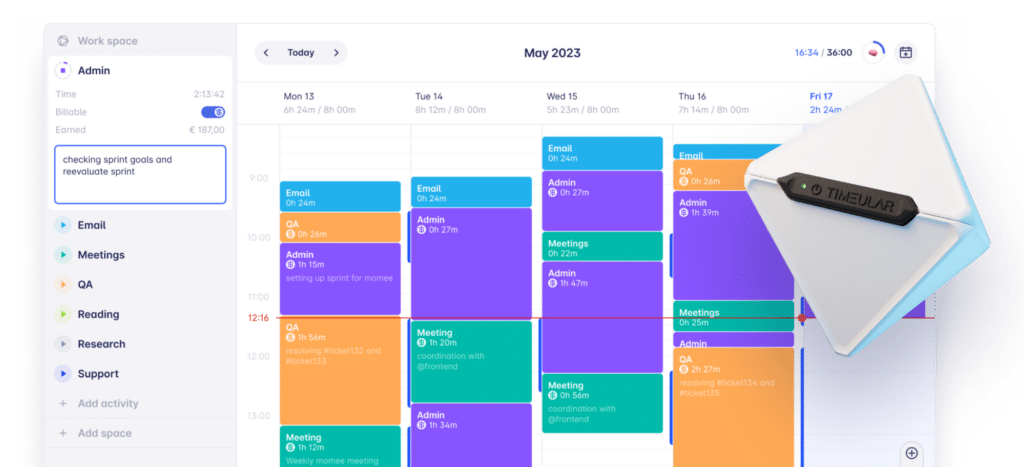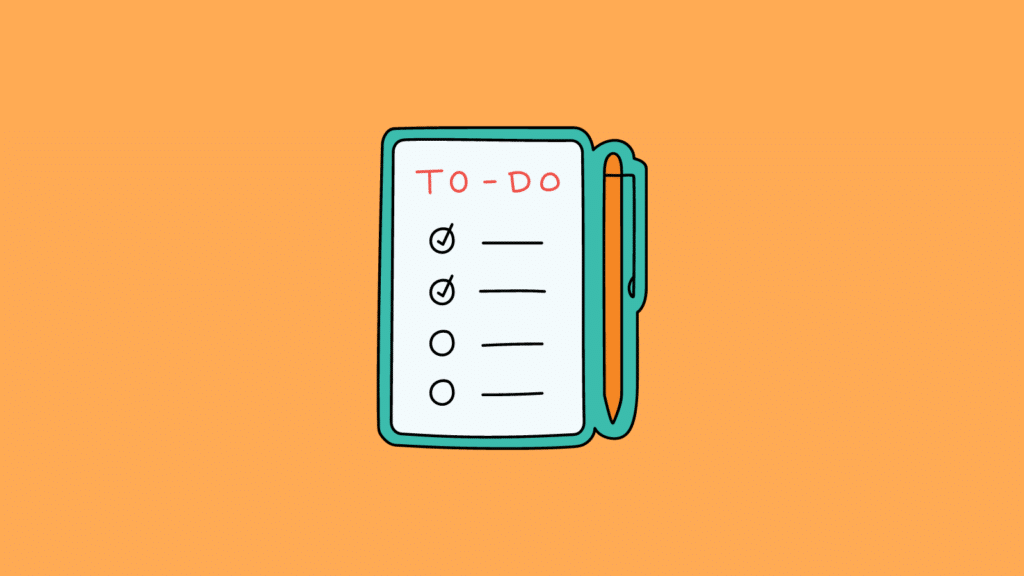How to Stop Procrastinating and Go Back on Track
Procrastination is the act of delaying or postponing tasks, a phenomenon familiar to almost everyone. At its core, it’s not just about poor time management but a complex interplay of psychological factors.
Everyone, at some point, finds themselves putting off tasks, whether small daily chores or significant work assignments. This article aims to demystify procrastination, exploring its underlying causes and the universal nature of this habit.
In this article, you will learn how to stop procrastinating.

One of the most effective tactics to stop procrastinating is to track your time
Gain a sense of what you’re doing with your time with a simple, effortless and secure time tracking solution
We’ll dive into various topics, including psychological reasons behind procrastination, strategies to stop procrastination, and practical steps to enhance productivity and break the cycle of delay that affects so many of us.
What is procrastination?
Procrastination is delaying tasks for “later”, despite knowing the potential negative outcomes. It often stems from psychological challenges like fear of failure, task complexity, perfectionism, or a mismatch between the task and personal interests.
It differs from laziness, which is a lack of interest in action, as procrastination involves a mental struggle with specific tasks due to these mental barriers. This habit can significantly impact work, leading to missed deadlines, stress, and poor quality outcomes. However, it’s manageable.
Employing strategies like effective time management, realistic goal-setting, and understanding personal procrastination triggers can help individuals overcome this pattern, boosting productivity and work attitude.
Why do we procrastinate?
The first step towards overcoming procrastination and the negative emotions it results in is to identify the reasons behind such a behavior. Understanding why you procrastinate is key, as it helps you come up with the right tactics to tackle your specific reasons and choose strategies to get a better handle on things.
Let’s take a closer look at the reasons for the procrastination habit:
- Perfectionism: Procrastination can occur when you set unrealistic expectations for perfection. The fear that your work won’t meet these high standards often leads to a cycle of delaying tasks, as the pressure of achieving perfection becomes overwhelming. This mindset can significantly hinder starting or completing tasks.
- Overwhelm: The procrastination problem can occur when you need to handle large tasks that seem so complex that it feels daunting to even begin. Feeling overwhelmed by a big project is natural.
- Lack of motivation: Negative feelings towards a particular task: When a task doesn’t feel rewarding or interesting, it’s tough to get motivated to begin or complete it, which often leads to putting it off and not taking action.
- Decision paralysis: When you can’t decide how to tackle important tasks, it often leads to procrastination. This indecision, or the fear of choosing poorly, can freeze you in the present moment, stopping any progress.
- Poor time management skills: Some people procrastinate because they underestimate the time a task will take or overestimate their own ability to complete it quickly later.
- Impulse control issues: Struggling to resist distractions can lead to procrastination, as you might opt for unimportant tasks offering immediate satisfaction over those with long-term benefits, letting down your future self.
Consequences of chronic procrastination
In a business environment, procrastination not only impacts individual productivity but can also have ripple effects on team dynamics and overall business outcomes. These are good reasons to try to avoid procrastination:
- Decreased performance: Chronic procrastination often leads to rushed, last-minute efforts, resulting in lower-quality work and poor outcomes.
- Increased stress: Delaying tasks until the last moment can cause significant stress and anxiety as deadlines approach with much left to do.
- Financial consequences: Procrastination can lead to missed deadlines for bills or investments, resulting in financial penalties or lost opportunities for financial growth.
- Strained relationships: Procrastinating important tasks can strain personal and professional relationships, as it often burdens others who may have to compensate for the procrastinator’s delays.
How to stop procrastinating
The good news is that it’s possible to overcome procrastination. The most important thing is to identify if you procrastinate, and if so, understand the reasons behind it.
Additionally, there are many productivity hacks that will help you make sure that the most important tasks will always be handled first.
Let’s get straight into it.
1. Admit that you procrastinate
Recognizing that you procrastinate is the first crucial step in addressing it. Many who procrastinate tend to deny their tendency to delay tasks, exacerbating the issue.
By accepting your habit of chronic procrastination, you can gain a clearer understanding of the challenges you face and develop a strategic plan to overcome them.
2. Understand why you’re procrastinating
Understanding why you procrastinate is crucial for overcoming it. Tasks that are boring, stressful, or challenging often lead to procrastination.
According to psychology expert Joseph Ferrari, this tendency is linked to difficulty in managing negative emotions and a lack of self-control.
Recognizing patterns from your past procrastination, especially thoughts like “I’ll never get this right,” can help you develop effective strategies to complete tasks and combat procrastination.
3. Set reasonable goals
Understanding our tendency to procrastinate and its reasons is vital, but it’s equally critical to set realistic goals. This approach is key because it helps maintain motivation and progress.
For activities like writing, apply SMART work goals: Specific, Measurable, Attainable, Realistic, Time-Oriented, with specific deadlines.
A big task or broad work-related goals, like “Overhauling the entire marketing strategy,” can be daunting. Break them down into smaller, manageable tasks such as “Analyzing current campaign performance” or “Researching new market trends.” It’s easier to work on six tasks, which are smaller, than on one big task.
This approach not only facilitates systematic completion but also underscores the importance of setting realistic goals: it helps prevent frustration and reduces the chances of abandoning the project.
4. Use a time-tracking app
Our main recommendation for you to stop procrastinating and become more productive is to gain a sense of what you’re doing with your time by using a time-tracking app.
Procrastinators usually feel that a whole day has gone by and they haven’t done what they needed to do, but realizing what a waste of time that is can be the turning point.
After all, we all know it — time is money!
Using time management tools allows you to know exactly how much time you spend on each task and optimize it. Use Timeular with its effortless, smart, and secure time-tracking methods:
- Automated time tracking: Fill in your time sheets automatically based on app usage, visited websites and scheduled calendar events.
- Use a physical time tracker: Make time tracking tactile and easily track 1,000 activities using just 8 sides. Build a habit using muscle memory and a powerful physical reminder.
- Use keyboard shortcuts and more!

You need a simple, yet robust time tracking tool
Try Timeular which was recognized as the most user-friendly time tracking app for teams and individuals
5. Use powerful time management techniques
If you’ve only just embarked on a journey against procrastination, you may not be aware that there are dozens (if not hundreds!) of time management techniques. They all have the same goal — to make you more productive.
Find 3 sample techniques below:
- Timeboxing: It’s a productivity technique where tasks are assigned fixed, realistic deadlines, ranging from minutes to months. It emphasizes completing your responsibilities within these set time limits, enhancing focus and efficiency. This method is valued in Agile methodologies and by entrepreneurs for its effectiveness.
- Time blocking: Time blocking is a strategy that organizes your day into specific timed slots for each task, turning your to-do list into a structured schedule. This method allocates focused time for tasks, allowing adjustments and ensuring efficiency. It’s about dedicating periods for work to enhance focus and reduce distractions, thus boosting productivity. (Download: Google sheets time blocking templates)
- Task batching: This productivity strategy involves grouping similar tasks and addressing them in designated time blocks. Its goal is to reduce interruptions and boost focus and efficiency by concentrating on a series of related tasks without frequent switching or disruptions.
TIP: A free work schedule template might be an interesting resource to help you with these techniques.
6. Write to-do lists
Implementing a to-do list is a highly effective way to transform your plan into concrete, measurable steps.
Begin each day by creating a list of tasks, dividing your day into smaller, manageable activities. This is useful whether it’s for a workday, a leisurely weekend, or even a holiday you wish to fully enjoy.
As you progress through your tasks list, ticking off each activity becomes a source of satisfaction.
The to-do list approach offers numerous advantages, such as:
- Serving as a motivational tool by visually tracking your progress
- Providing a sense of achievement
- Enhancing time management by clearly outlining your tasks and the time available to complete them
- Alleviating stress and anxiety
- And ultimately, it steers you towards becoming more organized and productive, which is the ultimate goal!
6. Prioritize
Prioritization is a fundamental strategy to avoid procrastinating, and a key element in this approach is the use of prioritization techniques like Pickle Jar or the 4 Quadrants of Time Management Matrix.
This method, originated by US President Dwight Eisenhower and popularized by Stephen Covey in one of the best productivity books, “The 7 Habits of Highly Effective People,” effectively categorizes tasks into four quadrants based on urgency and importance:
- Quadrant 1: Urgent and important
- Quadrant 2: Not urgent yet important
- Quadrant 3: Urgent but not important
- Quadrant 4: Not urgent and not important
By prioritizing tasks using this matrix, you can focus on what truly needs to be completed, reducing the feeling of being overwhelmed.
This prioritization helps in identifying which tasks are essential and need immediate attention (Quadrants 1 and 2) and which can be deferred or delegated (Quadrants 3 and 4).
Consequently, this clarity aids in tackling important tasks first, thereby reducing the tendency to procrastinate.

Free eBook: How to work smart, not hard
Overcome procrastination and focus on activities which bring you the best results
7. Try the “Eat The Frog” technique
Inspired by Mark Twain’s advice to “eat a frog” first thing in the morning, the “Eat The Frog” technique of overcoming procrastination focuses on tackling your most important task (and often most avoided) early in the day.
This approach helps you focus and directs your energy to completing the most daunting item on your to-do list first.
Ideal for those who find prioritizing challenging, this technique simplifies task management. Instead of complex methods, “Eat The Frog” involves selecting one significant task and dealing with it upfront, clearing a major hurdle and setting the tone for productivity.
In an environment rife with distractions like emails, calls, and social media, it’s crucial to maintain focus while completing this key task, ensuring no interruptions until it’s done.
Read also: The top-rated tools for workload prioritization
8. Implement the MoSCoW method
The MoSCoW prioritization method is a prioritization technique for efficiently organizing project workloads. It categorizes tasks into four groups: Must-have, Should have, Could have, and Won’t have, helping to prioritize each project feature and requirement. This ranking system guides everyone toward the project’s successful completion.
At its core, the MoSCoW method focuses on meeting project deadlines through a prioritization chart that emphasizes the most critical tasks. This strategy filters out less urgent or dispensable tasks, streamlining focus. It’s also valuable for teams, aligning tasks with company values and ensuring a unified approach towards common objectives.
9. Use the Pomodoro technique
The Pomodoro Technique is a time management method developed in the 1980s by Italian student Francesco Cirillo. Named after the Italian word for tomato, it was inspired by Cirillo’s use of a tomato-shaped kitchen timer to enhance his study focus. The technique involves the following steps:
- Create a to-do list: List out the things you need to complete.
- Set a Pomodoro timer for 25 minutes: Choose one task from your list and dedicate 25 minutes of uninterrupted work to it.
- Work until the timer rings: Enter into the deep work mode and focus solely on the selected task during this time.
- Record progress after 25 minutes: At the end of the timer, note what you’ve accomplished.
- Take a five-minute break: After each 25-minute work session, or ‘Pomodoro,’ take a short break to rest.
- Repeat the process: Continue this cycle, and after completing four ‘Pomodoros,’ take a longer break of 15-30 minutes.
Key points of the Pomodoro Technique include grouping tasks that take less than 25 minutes and avoiding all interruptions during each Pomodoro.
Conclusion
It’s in our human nature to put off as long as possible doing the things that cause us a bad feeling. However, procrastination has negative consequences, especially when it becomes chronic, and should be countered.
The tips and techniques we teach you in this guide about overcoming procrastination will definitely help you create healthier time management habits. There is only one thing left to do: stop procrastinating and start applying them!
FAQ
What does procrastinate mean?
Procrastination is the voluntary act of putting off an action that needs to be done, even though one knows that there will be negative consequences. Usually, the action that the procrastinator postpones is unpleasant or tedious.
Is procrastination a mental illness?
Procrastination itself is not a mental illness or disorder. However, it is commonly interpreted as a symptom of certain mental disorders like ADHD, Depression, and Anxiety.
Is procrastination a sign of ADHD?
To date, no scientific study has demonstrated a direct link between Procrastination and ADHD. However, a common characteristic of people with ADHD is difficulty managing their time, which can lead to procrastination. There are several tips to stop ADHD procrastination; get to know them.
Are procrastination and laziness the same?
No. Procrastination and Laziness are neither the same nor the result of each other. Scientific studies have shown that we procrastinate due to poor mood management, not laziness or poor time management.
You might be interested in:





